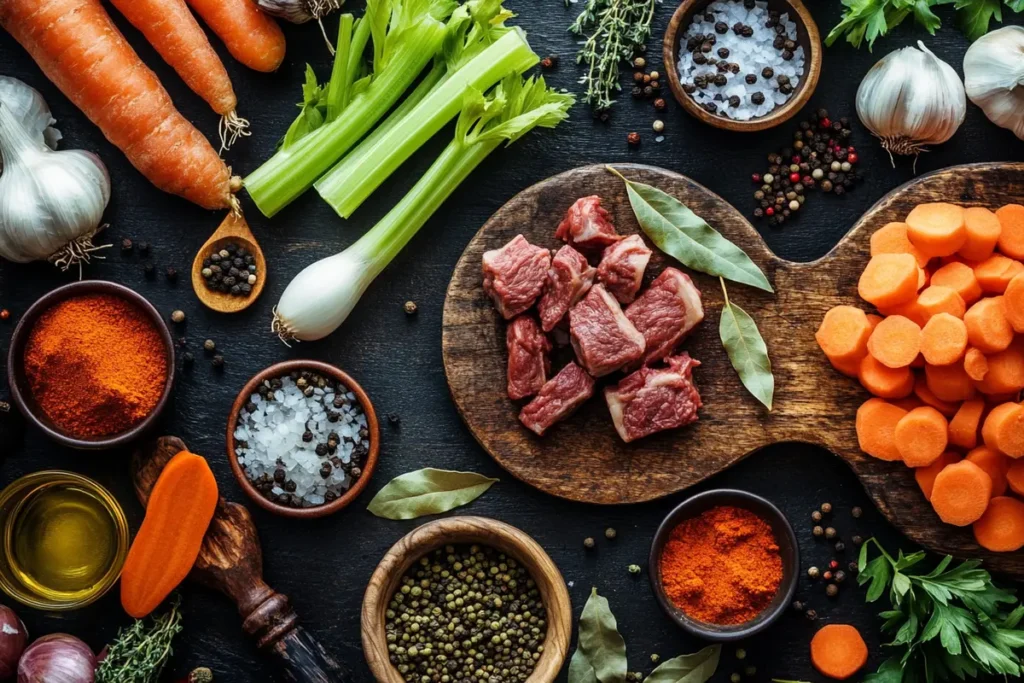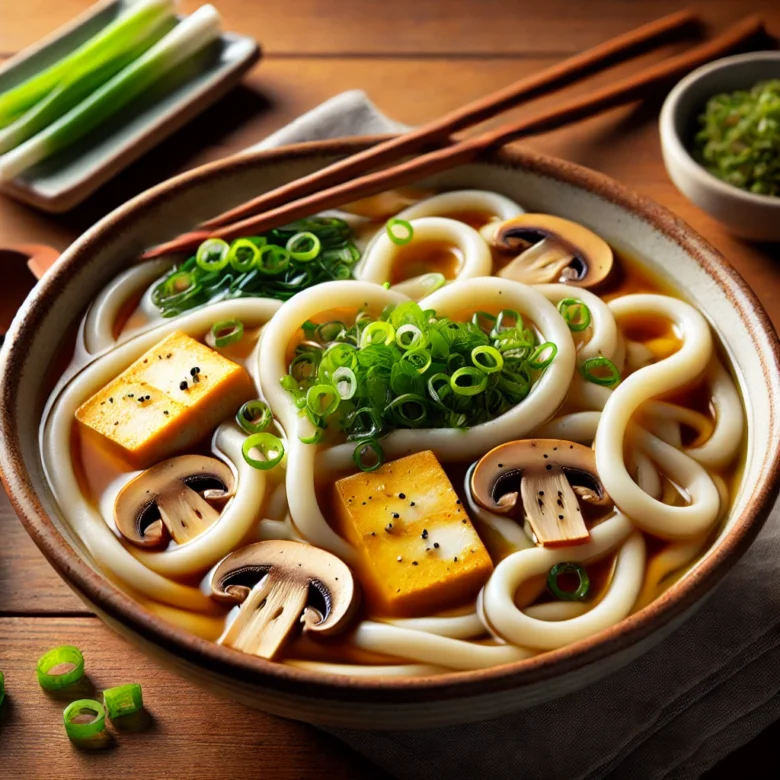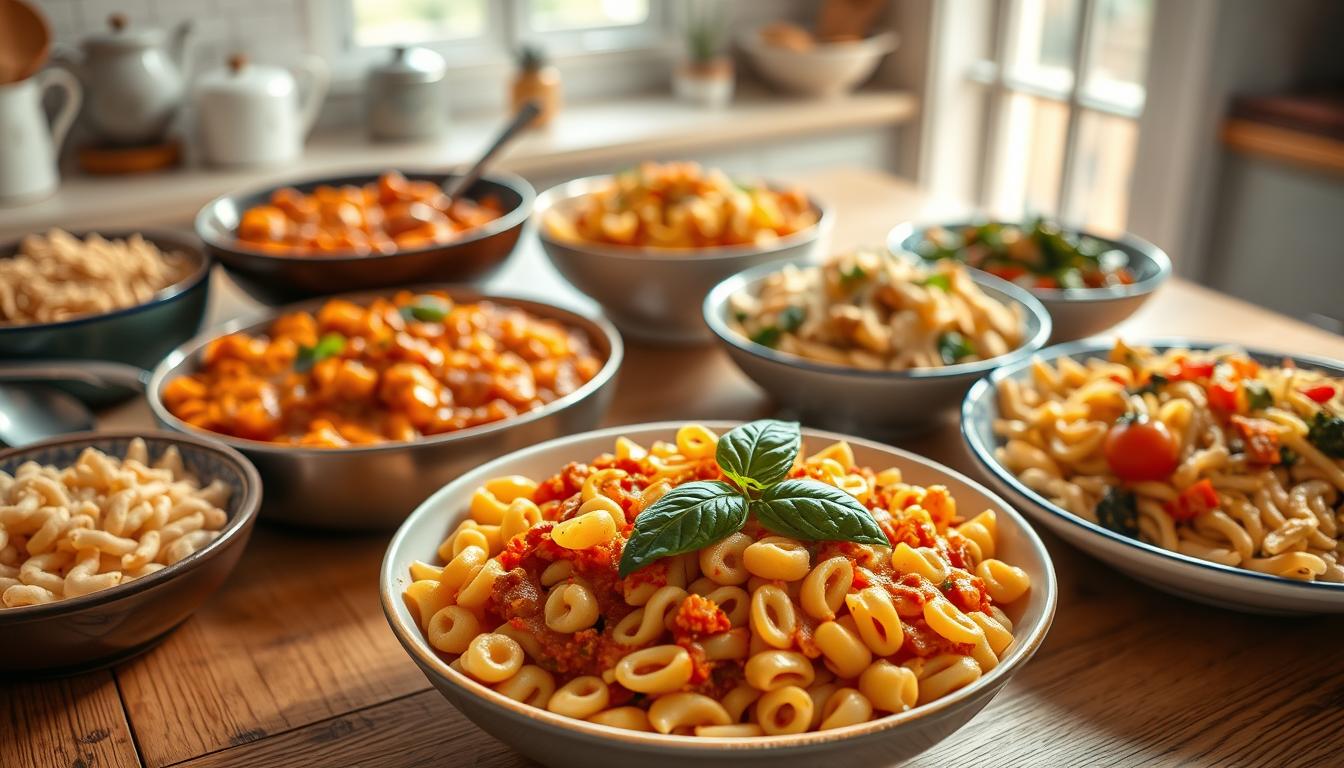Discover the ultimate soup bone recipe that delivers a rich, flavorful broth every time. Learn essential tips, variations, and step-by-step instructions to master this culinary staple.
When it comes to creating a nourishing and flavorful meal, nothing quite compares to a well-made soup bone recipe. Whether you’re a seasoned cook or just starting out, mastering this recipe will elevate your soups, stews, and sauces to new heights. This comprehensive guide will walk you through selecting the right bones, preparing them properly, and simmering to perfection, ensuring your broth is both delicious and packed with nutrients.
In the sections below, we’ll delve into the essential components of a soup bone recipe, provide detailed preparation steps, explore creative variations, and address common questions to help you achieve the perfect broth every time. By the end of this guide, you’ll be equipped with all the knowledge you need to create a hearty and satisfying soup bone recipe that will become a staple in your kitchen.
Why a Soup Bone Recipe is Essential in Your Kitchen
A soup bone recipe is more than just a method for making broth; it’s a foundational element that can enhance a wide array of dishes. Here’s why incorporating this recipe into your cooking routine is a game-changer:
1. Rich Flavor and Depth
A well-crafted soup bone recipe results in a broth that is deeply flavorful and rich. The slow simmering of bones releases collagen, marrow, and minerals, creating a savory base that enhances the taste of any soup or stew.
2. Nutritional Benefits
Soup bone recipes are packed with nutrients. The bones release essential minerals like calcium, magnesium, and phosphorus, as well as amino acids such as glycine and proline, which support joint health, skin elasticity, and overall wellness.
3. Versatility in Cooking
The broth produced from a soup bone recipe serves as a versatile base for numerous dishes. From classic chicken noodle soup to hearty beef stews and even risottos, the possibilities are endless. It can also be used to cook grains and legumes, infusing them with rich flavor.
4. Economic and Sustainable Choice
Using bones, which are often less expensive cuts of meat, is an economical way to create a high-quality broth. Additionally, it promotes sustainable cooking practices by utilizing every part of the animal, reducing food waste.
5. Customizable to Your Taste
A soup bone recipe can be easily tailored to suit your personal preferences. Whether you prefer a clear, delicate broth or a thick, hearty one, adjustments in ingredients and simmering time allow you to customize the broth to your liking.
Essential Ingredients for a Soup Bone Recipe
Creating the perfect soup bone recipe starts with selecting high-quality ingredients. Each component plays a crucial role in developing the flavor, texture, and nutritional value of the broth.
1. Quality Soup Bones
The cornerstone of any soup bone recipe is the bones themselves. Choosing the right bones ensures a flavorful and nutrient-dense broth.
- Beef Bones: Marrow bones, knuckle bones, and oxtail are excellent choices for a robust, savory broth.
- Chicken Bones: Carcasses, necks, and feet are ideal for a lighter, more delicate broth.
- Pork Bones: Leg bones and hocks can add a unique flavor profile to your broth.
2. Fresh Vegetables
Vegetables add depth and natural sweetness to the broth, balancing the richness of the bones.
- Onions: Provide a savory base.
- Carrots: Add sweetness and color.
- Celery: Enhances the broth’s aromatic profile.
- Garlic: Infuses the broth with robust flavor.
3. Aromatics and Herbs
Aromatics and herbs elevate the flavor of your broth, making it more complex and aromatic.
- Bay Leaves: Add a subtle earthy flavor.
- Thyme: Contributes a fresh, herbal note.
- Parsley Stems: Infuse a light, clean taste.
- Peppercorns: Provide a mild heat and spice.
4. Acidic Component
Adding an acidic component helps extract minerals from the bones, enriching the broth.
- Apple Cider Vinegar: A popular choice for its mild acidity.
- Lemon Juice: Adds a fresh, citrusy tang.
- Tomato Paste: Introduces a hint of sweetness and acidity.
5. Water
The primary liquid for simmering the broth.
- Filtered Water: Ensures a clean taste without impurities.
6. Optional Add-Ins
For added flavor and complexity, consider incorporating optional ingredients.
- Mushrooms: Enhance umami depth.
- Leeks: Add a subtle onion-like flavor.
- Ginger: Introduces a hint of spice and warmth.
Ingredient Selection Tips
- Quality Matters: Use fresh, high-quality bones and vegetables for the best flavor and nutrition.
- Organic and Grass-Fed: Whenever possible, choose organic and grass-fed bones to ensure a cleaner, more nutrient-dense broth.
- Seasonal Vegetables: Incorporate seasonal vegetables to take advantage of their peak flavors and availability.
Step-by-Step Instructions for a Perfect Soup Bone Recipe

Crafting a perfect soup bone recipe involves careful preparation and patience. Follow these detailed steps to create a rich and flavorful broth:
1. Preparing the Bones
Proper preparation of the bones is essential to remove impurities and achieve a clear broth.
- Rinse Thoroughly: Rinse the bones under cold water to remove any residual blood or bone fragments.
- Blanch the Bones: Place the bones in a large pot and cover with cold water. Bring to a boil and blanch for 10-15 minutes. This process removes impurities and excess fat.
- Drain and Rinse: After blanching, drain the bones and rinse them under cold water to ensure a clean start for your broth.
2. Creating the Broth Base
Building a flavorful base is key to a delicious soup bone recipe.
- Combine Bones and Water: Place the cleaned bones in a large stockpot and cover with filtered water. The general ratio is about 2 pounds of bones per 8 cups of water.
- Add Acidic Component: Pour in 2 tablespoons of apple cider vinegar or your chosen acidic ingredient. This helps extract minerals from the bones.
- Simmer Slowly: Bring the mixture to a boil over medium-high heat, then reduce to a low simmer. Avoid boiling, as it can make the broth cloudy.
- Skim Impurities: As the broth simmers, foam and impurities will rise to the surface. Skim these off with a spoon to ensure a clear broth.
3. Adding Vegetables and Aromatics
Enhancing the broth with vegetables and aromatics infuses it with rich flavors.
- Chop Vegetables: Dice onions, carrots, and celery into large chunks. Add them to the pot.
- Incorporate Aromatics: Toss in garlic cloves, bay leaves, thyme sprigs, and a handful of parsley stems.
- Season Lightly: Add about 1 teaspoon of whole peppercorns for subtle spice.
4. Simmering the Broth
Patience is key to extracting maximum flavor and nutrients.
- Low and Slow: Let the broth simmer on low heat for 4-6 hours. For a more intense flavor, simmer up to 12 hours.
- Maintain Simmer: Keep the heat low enough that the broth barely bubbles. This gentle cooking process ensures clarity and richness.
- Check Occasionally: Every hour, check the broth and skim off any additional impurities that may form.
5. Straining the Broth
Removing solids is crucial for a smooth, clear broth.
- Use Fine Mesh Strainer: Once the simmering is complete, remove the pot from heat and let it cool slightly.
- Strain Thoroughly: Pour the broth through a fine mesh strainer or cheesecloth into another large pot or container. Discard the bones and vegetable solids.
- Cool and Skim Fat: Allow the broth to cool completely. Once chilled, any excess fat will solidify on the surface. Skim this off for a leaner broth, or leave it if you prefer a richer flavor.
6. Storing and Using Your Soup Bone Recipe
Proper storage ensures your broth remains fresh and ready for use.
- Refrigerate: Store the broth in airtight containers in the refrigerator for up to five days.
- Freeze: For longer storage, pour the broth into freezer-safe containers or ice cube trays. Frozen broth can last up to three months.
- Utilize the Broth: Use your homemade broth as a base for soups, stews, gravies, or to cook grains and legumes for added flavor.
Creative Variations and Flavor Twists for Your Soup Bone Recipe
While the classic soup bone recipe is delicious on its own, adding variations can enhance the flavor and cater to different preferences. Here are some creative twists to try:
1. Vegetable-Enriched Broth
Add more vegetables to increase the nutritional value and depth of flavor.
- Ingredients: Include mushrooms, leeks, and sweet potatoes.
- Method: Add these additional vegetables during the simmering process to infuse their flavors into the broth.
2. Spicy Bone Broth
Introduce heat for a bold, spicy kick.
- Ingredients: Add red pepper flakes, jalapeño slices, or a splash of hot sauce.
- Method: Incorporate these spices gradually and adjust to taste, adding them towards the end of simmering to maintain their vibrant flavors.
3. Herbed Bone Broth
Elevate the broth with fresh herbs for a fragrant aroma.
- Ingredients: Use rosemary, dill, or basil in addition to the standard herbs.
- Method: Add fresh herb sprigs during the simmering process and remove them before straining.
4. Asian-Inspired Bone Broth
Infuse your broth with Asian flavors for an exotic twist.
- Ingredients: Incorporate ginger slices, star anise, and soy sauce.
- Method: Add these ingredients early in the simmering process to allow the flavors to meld beautifully.
5. Bone Broth with Added Protein
Boost the protein content for a more substantial meal base.
- Ingredients: Include shredded chicken, beef chunks, or tofu cubes.
- Method: Add these proteins during the last hour of simmering to prevent overcooking.
6. Bone Broth for Dogs
Create a safe and nutritious broth for your furry friends.
- Ingredients: Use chicken or beef bones, avoiding any seasoning or additives.
- Method: Simmer the bones with water until the broth is clear. Cool and remove any fat before serving to your dog.
7. Creamy Bone Broth
Transform your broth into a creamy soup base.
- Ingredients: Add coconut milk, heavy cream, or cashew cream.
- Method: Stir in the creamy component after straining the broth and gently heat until combined.
8. Bone Broth with Grains
Make your broth a complete meal by adding grains.
- Ingredients: Incorporate quinoa, barley, or rice.
- Method: Add the grains to the simmering broth and cook until tender, infusing the grains with rich flavor.
9. Bone Broth with Root Vegetables
Enhance the sweetness and heartiness with additional root vegetables.
- Ingredients: Add parsnips, turnips, or rutabagas.
- Method: Include these vegetables during the simmering process to allow their flavors to integrate into the broth.
10. Bone Broth with Legumes
Increase the fiber and protein by adding legumes.
- Ingredients: Include lentils, chickpeas, or beans.
- Method: Add legumes during the last hour of simmering to ensure they cook properly without becoming mushy.
These variations not only diversify the flavor of your soup bone recipe but also enhance its nutritional profile, making it a versatile addition to your cooking repertoire. Experimenting with these twists can keep your meals exciting and ensure there’s always a new favorite among your favorite recipes.
Essential Tips for Crafting the Perfect Soup Bone Recipe
Achieving the perfect soup bone recipe requires attention to detail and some thoughtful techniques. Here are essential tips to ensure your broth turns out delicious every time:
1. Use Fresh Ingredients
- Why It Matters: Fresh bones and vegetables enhance the soup’s flavor and nutritional value.
- Tip: Choose organic or grass-fed bones when possible for a cleaner, more nutrient-dense broth.
2. Simmer Low and Slow
- Why It Matters: Slow simmering allows for maximum flavor extraction and collagen release.
- Tip: Keep the heat low to maintain a gentle simmer, avoiding vigorous boiling which can make the broth cloudy.
3. Skim Off Impurities
- Why It Matters: Removing foam and impurities results in a clearer, cleaner-tasting broth.
- Tip: Use a ladle or spoon to gently skim off any foam that rises to the surface periodically.
4. Balance the Flavors
- Why It Matters: Achieving the right balance between salty, sweet, and savory elements is crucial for a well-rounded broth.
- Tip: Taste the broth as it cooks and adjust seasoning with salt, pepper, or herbs as needed.
5. Don’t Rush the Process
- Why It Matters: Allowing adequate time for simmering ensures that all ingredients contribute fully to the broth’s flavor.
- Tip: Plan to cook your broth for at least 4 hours, preferably longer for optimal flavor extraction.
6. Customize with Add-Ins
- Why It Matters: Adding different ingredients can elevate the broth and cater to personal preferences.
- Tip: Experiment with seasonal vegetables or unique spices to keep the broth interesting.
7. Proper Storage
- Why It Matters: Storing broth correctly maintains its flavor and prevents spoilage.
- Tip: Refrigerate the broth in airtight containers and consume within 5 days, or freeze for longer storage.
8. Reheating Correctly
- Why It Matters: Proper reheating preserves the broth’s texture and flavor.
- Tip: Gently reheat on the stovetop over low heat, stirring occasionally to ensure even heating.
9. Enhance with Acid
- Why It Matters: A touch of acidity can brighten the broth’s flavor.
- Tip: Add a splash of apple cider vinegar or lemon juice before serving to enhance the taste.
10. Strain Thoroughly
- Why It Matters: Ensures a smooth, clear broth free from solid impurities.
- Tip: Use a fine mesh strainer or cheesecloth to strain the broth effectively.
Implementing these tips will help you create an exceptional soup bone recipe that’s both flavorful and nutritious. Attention to ingredient quality, cooking techniques, and thoughtful adjustments ensures that your broth stands out as a delicious and versatile meal option.
Adjusting Your Soup Bone Recipe for Special Diets

Soup bone recipes are incredibly versatile and can be easily adapted to meet various dietary requirements. Whether you’re catering to vegan, gluten-free, or low-sodium needs, here’s how to modify your recipe accordingly:
1. Vegan Soup Bone Recipe
- Substitute Proteins: Use plant-based proteins like tofu, tempeh, or seitan instead of meat.
- Replace Broth: Opt for vegetable broth to keep the soup vegan-friendly.
- Add Legumes: Incorporate beans or lentils for additional protein and fiber.
2. Gluten-Free Soup Bone Recipe
- Check Ingredients: Ensure all ingredients, including broth and seasonings, are gluten-free.
- Avoid Cross-Contamination: Use separate utensils and cookware if you’re preparing other gluten-containing foods.
- Add Gluten-Free Grains: Include quinoa or rice to add texture and substance without gluten.
3. Low-Sodium Soup Bone Recipe
- Use Low-Sodium Broth: Choose low-sodium or no-salt-added broth to control the sodium levels.
- Limit Added Salt: Reduce or omit additional salt in the recipe. Enhance flavor with herbs and spices instead.
- Incorporate Fresh Herbs: Use fresh herbs like parsley, cilantro, or basil to add flavor without sodium.
4. Diabetic-Friendly Soup Bone Recipe
- Reduce Carbohydrates: Limit high-carb vegetables like potatoes and carrots. Focus on low-carb options like leafy greens and zucchini.
- Choose Lean Proteins: Opt for lean cuts of meat or plant-based proteins to keep the soup heart-healthy.
- Avoid Sugary Add-Ins: Skip adding sweet ingredients like corn or certain beans that can spike blood sugar levels.
5. Keto-Friendly Soup Bone Recipe
- Low-Carb Vegetables: Use vegetables that are low in carbohydrates, such as spinach, kale, and broccoli.
- High-Fat Add-Ins: Incorporate high-fat ingredients like avocado or olive oil to align with keto macros.
- Avoid Starches: Exclude starchy vegetables like potatoes and corn to maintain ketosis.
6. Paleo Soup Bone Recipe
- Use Paleo-Friendly Broth: Ensure the broth is free from additives and conforms to paleo standards.
- Whole Food Ingredients: Focus on whole, unprocessed ingredients without grains or legumes.
- Enhance with Root Vegetables: Include paleo-approved root vegetables like sweet potatoes or carrots for natural sweetness and nutrition.
7. Allergy-Friendly Soup Bone Recipe
- Identify Allergens: Be aware of common allergens like dairy, nuts, or shellfish, and substitute accordingly.
- Use Alternative Thickeners: Replace flour-based thickeners with arrowroot or tapioca starch if needed.
- Ensure Safe Add-Ins: Double-check that all add-ins are free from allergens and processed in safe environments.
By tailoring your soup bone recipe to fit these special diets, you ensure that everyone can enjoy a warm, comforting bowl without compromising their nutritional needs or dietary restrictions. These adjustments make the broth inclusive and adaptable, perfect for family meals or gatherings with diverse dietary preferences.
Slicing, Serving, and Tasting Your Soup Bone Recipe
Once your soup bone recipe is perfectly cooked, the next steps involve serving and enjoying it in the best possible way. Proper slicing, serving, and tasting techniques enhance the overall dining experience. Follow these tips to make the most of your delicious broth:
1. Serving Suggestions
Enhance the presentation and flavor of your soup bone recipe with these serving ideas:
- Serve Hot: Ensure the broth is served steaming hot for the best flavor and comfort.
- Accompaniments: Pair with crusty bread, rolls, or a side salad for a complete meal.
- Garnishes: Add fresh herbs like parsley or cilantro, a dollop of sour cream, or grated cheese for added flavor and presentation.
2. Presentation Tips
- Use Attractive Bowls: Present the soup in visually appealing bowls to make the meal feel special.
- Color Contrast: Garnish with colorful ingredients like green herbs or vibrant vegetables to add visual interest.
- Layering Flavors: Layer different textures and flavors through garnishes to create a more complex and enjoyable eating experience.
3. Tasting and Enjoying
To fully appreciate your soup bone recipe, follow these tasting tips:
- Taste Before Seasoning: Sample the broth before adding extra salt or spices to ensure the flavors are balanced.
- Adjust Seasonings: If needed, adjust the seasoning to suit your taste preferences, adding more herbs or spices for extra depth.
- Enjoy Mindfully: Take the time to savor each spoonful, appreciating the blend of flavors and textures that make soup bone recipe so satisfying.
4. Leftover Utilization
Maximize the use of your soup bone recipe by repurposing leftovers creatively:
- Storage: Store any leftovers in airtight containers in the refrigerator for up to five days or freeze for longer storage.
- Creative Uses: Use leftover broth as a base for other dishes, such as adding extra vegetables, grains, or proteins to create a new meal.
- Enhance with Fresh Ingredients: Reheat the broth and add fresh herbs or a squeeze of lemon juice to brighten the flavors before serving again.
5. Pairing with Beverages
Complement your soup bone recipe with the right beverages for an enhanced dining experience:
- Tea: Herbal teas like chamomile or green tea pair well, offering a soothing contrast to the rich broth.
- Wine: A glass of white wine, such as Chardonnay or Sauvignon Blanc, can complement the savory flavors of the broth.
- Juices: Fresh vegetable juices like carrot or beet juice can add a refreshing element to the meal.
By following these slicing, serving, and tasting techniques, your soup bone recipe will not only taste amazing but also look and feel like a delightful and nourishing meal.
Storing and Freezing Your Soup Bone Recipe
Proper storage ensures that your soup bone recipe remains fresh, flavorful, and safe to consume for days after preparation. Here’s how to store and freeze your broth effectively:
1. Refrigerating Your Soup
- Cooling First: Let the soup cool to room temperature before refrigerating to prevent condensation and sogginess.
- Use Airtight Containers: Transfer the soup to airtight containers to maintain freshness and prevent absorption of other odors.
- Shelf Life: Stored in the refrigerator, soup bone recipe broth will stay fresh for up to five days. Always check for signs of spoilage before reheating.
2. Freezing for Long-Term Storage
- Portioning: Divide the broth into individual or family-sized portions using freezer-safe containers or resealable plastic bags.
- Labeling: Clearly label each container with the date and contents to keep track of storage times.
- Freezer Life: Frozen soup bone recipe broth can last up to three months without significant loss of quality.
3. Thawing and Reheating
- Thawing: Move the frozen broth from the freezer to the refrigerator and let it thaw overnight for best results.
- Reheating: Gently reheat the soup on the stovetop over low heat, stirring occasionally to ensure even heating. Alternatively, use a microwave for quick reheating.
- Consistency Check: If the soup is too thick after thawing, add a bit of broth or water to reach your desired consistency.
4. Tips for Maintaining Freshness
- Avoid Repeated Freezing: Try to freeze only what you’ll consume within the freezer life to prevent texture degradation.
- Separate Components: If your soup contains ingredients that don’t freeze well, like certain vegetables or dairy products, consider adding them fresh after reheating.
- Prevent Freezer Burn: Ensure all containers are sealed tightly to protect the broth from freezer burn, which can alter the flavor and texture.
5. Safe Storage Practices
- Cool Quickly: Refrigerate the soup within two hours of cooking to minimize bacterial growth.
- Check Seals: Ensure containers are properly sealed to maintain hygiene and prevent contamination.
- Use Clean Utensils: Always use clean utensils when serving or storing the soup to avoid introducing bacteria.
By following these storage and freezing guidelines, you can enjoy your soup bone recipe over an extended period without sacrificing its delicious taste and nutritious qualities.
Troubleshooting Common Issues in a Soup Bone Recipe
Even with a perfect recipe, some challenges might arise when making a soup bone recipe. Here are common issues and how to resolve them to ensure your broth turns out perfectly every time:
1. Soup Too Thick
- Cause: Excessive reduction during simmering or too many solid ingredients.
- Solution: Add more broth or water to reach the desired consistency. Stir well and let it simmer for a few more minutes to integrate the added liquid.
2. Soup Too Thin
- Cause: Insufficient reduction or lack of thickening agents.
- Solution: Let the soup simmer uncovered to allow more liquid to evaporate. Alternatively, add a slurry of cornstarch and water to thicken the soup quickly.
3. Lack of Flavor
- Cause: Under-seasoning or using bland ingredients.
- Solution: Taste the soup and adjust the seasoning with salt, pepper, and additional herbs or spices. Incorporate umami-rich ingredients like soy sauce or Worcestershire sauce for depth.
4. Overcooked Vegetables
- Cause: Cooking vegetables for too long, resulting in mushy texture.
- Solution: Add vegetables later in the cooking process or cut them into larger pieces that take longer to cook without disintegrating.
5. Undercooked Meat
- Cause: Insufficient simmering time for tougher cuts of meat.
- Solution: Ensure the soup simmers long enough to tenderize the meat completely. If using leaner cuts, consider pre-cooking or marinating to enhance tenderness.
6. Bitter Taste
- Cause: Overcooking the bones or adding too many strong herbs.
- Solution: Avoid over-simmering the bones and balance strong flavors with sweet or acidic elements like a splash of lemon juice or a pinch of sugar.
7. Cloudy Broth
- Cause: Vigorous boiling or not skimming impurities.
- Solution: Keep the soup at a gentle simmer and regularly skim off any foam or impurities that rise to the surface to maintain a clear broth.
8. Uneven Flavor Distribution
- Cause: Ingredients not evenly distributed throughout the soup.
- Solution: Stir the soup thoroughly, ensuring that all ingredients are well incorporated and that seasoning is evenly spread.
9. Greasy Texture
- Cause: Excess fat from the soup bones not properly skimmed.
- Solution: After simmering, chill the soup and remove the solidified fat from the surface before reheating and serving.
10. Sour or Off Taste
- Cause: Spoiled ingredients or contamination.
- Solution: Always use fresh ingredients and store the soup properly. If the soup tastes off, it’s safer to discard it to avoid foodborne illness.
11. Mushy Meat or Vegetables
- Cause: Overcooking, particularly for delicate ingredients.
- Solution: Monitor cooking times closely and add delicate ingredients towards the end of the cooking process to preserve their texture.
12. Flat Broth
- Cause: Not enough seasoning or using low-quality broth.
- Solution: Enhance the broth with additional herbs, spices, or a splash of acid like vinegar or lemon juice to brighten the flavors.
By identifying and addressing these common issues, you can refine your soup bone recipe and ensure a delicious, well-balanced broth every time. Remember, cooking is a learning process, and each batch offers an opportunity to refine your techniques and achieve a more delicious result.
Frequently Asked Questions
To further assist you, here are answers to some commonly asked questions about a soup bone recipe:
1. Soup Bone Recipe
Q: What is a good recipe for using soup bones?
A: A basic soup bone recipe involves simmering beef or chicken soup bones with vegetables like carrots, celery, and onions, along with herbs such as thyme and bay leaves. Start by blanching the bones, then simmer them with vegetables and seasonings for several hours to create a rich broth. Strain the broth, return it to the pot, and add your desired vegetables and proteins to complete the soup.
2. Soup Bone for Dogs
Q: Can I use soup bones for making broth for dogs?
A: While some dog owners use beef soup bones to make homemade dog broth, it’s important to ensure the bones are raw and not cooked, as cooked bones can splinter and cause internal injuries. Always consult with a veterinarian before introducing new foods into your dog’s diet to ensure safety and suitability.
3. What to Do with Soup Bones Beef
Q: What should I do with beef soup bones in a soup bone recipe?
A: Beef soup bones are essential for creating a flavorful broth. Start by blanching the bones to remove impurities, then simmer them with vegetables and herbs for several hours. This slow cooking extracts the collagen and nutrients from the bones, resulting in a rich and nutritious broth that forms the base of your soup.
4. Soup Bone Near Me
Q: Where can I find beef soup bones near me?
A: Beef soup bones can be found at most local butcher shops, grocery stores with a butcher section, or specialty meat markets. You can also order them online from reputable suppliers who deliver fresh or frozen bones directly to your doorstep.
5. Beef Soup Bones Recipe
Q: Do you have a specific beef soup bones recipe?
A: Yes! Here’s a simple recipe:
Ingredients:
- 2 pounds beef soup bones
- 1 onion, quartered
- 2 carrots, chopped
- 2 celery stalks, chopped
- 3 cloves garlic, smashed
- 2 bay leaves
- 1 teaspoon black peppercorns
- 12 cups water
Instructions:
- Rinse the beef soup bones under cold water.
- Place the bones in a large pot and cover with water.
- Bring to a boil and blanch for 5 minutes. Drain and rinse the bones to remove impurities.
- Return the bones to the pot and add fresh water, onion, carrots, celery, garlic, bay leaves, and peppercorns.
- Bring to a boil, then reduce heat to a low simmer.
- Cover and let simmer for at least 4 hours, preferably longer for a richer broth.
- Strain the broth through a fine sieve, discarding the solids.
- Use the broth as the base for your soup or store it for future use.
6. Beef Soup Bones with Meat
Q: How do I use beef soup bones with meat in my broth?
A: Beef soup bones with meat are perfect for adding extra flavor and protein to your soup. After simmering the bones to create the broth, add the meat back into the pot along with additional vegetables and seasonings. Cook until the meat is tender and the flavors have melded together, resulting in a hearty and satisfying broth.
7. Beef Soup Bones Near Me
Q: Where can I purchase beef soup bones near me?
A: Beef soup bones are typically available at local butcher shops, grocery stores with a meat department, or farmers’ markets. Additionally, many online retailers offer delivery services for fresh or frozen soup bones, ensuring you have access to high-quality ingredients no matter your location.
8. Best Beef Bone Soup Recipe
Q: What is the best beef bone soup recipe?
A: The best beef bone soup recipe focuses on slow simmering to extract maximum flavor and nutrients from the bones. Here’s an optimized recipe:
Ingredients:
- 3 pounds beef soup bones
- 2 onions, quartered
- 3 carrots, chopped
- 3 celery stalks, chopped
- 4 cloves garlic, smashed
- 3 bay leaves
- 1 tablespoon apple cider vinegar
- 2 teaspoons salt
- 1 teaspoon black peppercorns
- 14 cups water
Instructions:
- Rinse beef soup bones thoroughly under cold water.
- Place the bones in a large stockpot and add water. Bring to a boil.
- Blanch the bones for 5 minutes, then drain and rinse to remove impurities.
- Return the bones to the pot and add fresh water, onions, carrots, celery, garlic, bay leaves, apple cider vinegar, salt, and peppercorns.
- Bring to a boil, then reduce heat to a low simmer.
- Cover and let simmer for 6-8 hours, occasionally skimming off any foam or fat that rises to the surface.
- Strain the broth through a fine mesh sieve, discarding the solids.
- Let the broth cool, then refrigerate or freeze for future use in your soup.
This recipe ensures a rich, flavorful broth that forms the perfect base for your soups, providing depth and nutrition in every bowl.
Conclusion
Mastering a soup bone recipe opens the door to a world of delicious and nutritious cooking. By carefully selecting high-quality bones and fresh vegetables, and by following meticulous simmering techniques, you can create a rich and flavorful broth that enhances a wide variety of dishes. Whether you’re making soups, stews, sauces, or simply enjoying a warm bowl on its own, this soup bone recipe is a versatile and essential addition to your culinary repertoire.
Moreover, adapting your soup bone recipe to cater to special diets ensures that everyone can enjoy the wholesome goodness of homemade broth. From vegan and gluten-free options to low-sodium and keto-friendly variations, this recipe’s flexibility makes it an invaluable staple in any kitchen.
Remember, the key to a perfect soup bone recipe lies in patience and attention to detail. Allowing the broth to simmer slowly extracts maximum flavor and nutrients, resulting in a broth that is both delicious and beneficial for your health. By implementing the tips and variations discussed, you can customize your broth to suit your taste preferences and dietary needs, ensuring a delightful and nourishing experience every time you cook.
Frequently Asked Questions
1. Soup Bone Recipe
Q: What is a good recipe for using soup bones?
A: A basic soup bone recipe involves simmering beef or chicken soup bones with vegetables like carrots, celery, and onions, along with herbs such as thyme and bay leaves. Start by blanching the bones, then simmer them with vegetables and seasonings for several hours to create a rich broth. Strain the broth, return it to the pot, and add your desired vegetables and proteins to complete the soup.
2. Soup Bone for Dogs
Q: Can I use soup bones for making broth for dogs?
A: While some dog owners use beef soup bones to make homemade dog broth, it’s important to ensure the bones are raw and not cooked, as cooked bones can splinter and cause internal injuries. Always consult with a veterinarian before introducing new foods into your dog’s diet to ensure safety and suitability.
3. What to Do with Soup Bones Beef
Q: What should I do with beef soup bones in a soup bone recipe?
A: Beef soup bones are essential for creating a flavorful broth. Start by blanching the bones to remove impurities, then simmer them with vegetables and herbs for several hours. This slow cooking extracts the collagen and nutrients from the bones, resulting in a rich and nutritious broth that forms the base of your soup.
4. Soup Bone Near Me
Q: Where can I find beef soup bones near me?
A: Beef soup bones can be found at most local butcher shops, grocery stores with a butcher section, or specialty meat markets. You can also order them online from reputable suppliers who deliver fresh or frozen bones directly to your doorstep.
5. Beef Soup Bones Recipe
Q: Do you have a specific beef soup bones recipe?
A: Yes! Here’s a simple recipe:
Ingredients:
- 2 pounds beef soup bones
- 1 onion, quartered
- 2 carrots, chopped
- 2 celery stalks, chopped
- 3 cloves garlic, smashed
- 2 bay leaves
- 1 teaspoon black peppercorns
- 12 cups water
Instructions:
- Rinse the beef soup bones under cold water.
- Place the bones in a large pot and cover with water.
- Bring to a boil and blanch for 5 minutes. Drain and rinse the bones to remove impurities.
- Return the bones to the pot and add fresh water, onion, carrots, celery, garlic, bay leaves, and peppercorns.
- Bring to a boil, then reduce heat to a low simmer.
- Cover and let simmer for at least 4 hours, preferably longer for a richer broth.
- Strain the broth through a fine sieve, discarding the solids.
- Use the broth as the base for your soup or store it for future use.
6. Beef Soup Bones with Meat
Q: How do I use beef soup bones with meat in my broth?
A: Beef soup bones with meat are perfect for adding extra flavor and protein to your soup. After simmering the bones to create the broth, add the meat back into the pot along with additional vegetables and seasonings. Cook until the meat is tender and the flavors have melded together, resulting in a hearty and satisfying broth.
7. Beef Soup Bones Near Me
Q: Where can I purchase beef soup bones near me?
A: Beef soup bones are typically available at local butcher shops, grocery stores with a meat department, or farmers’ markets.
8. Best Beef Bone Soup Recipe
Q: What is the best beef bone soup recipe?
A: The best beef bone soup recipe focuses on slow simmering to extract maximum flavor and nutrients from the bones. Here’s an optimized recipe:
Ingredients:
- 3 pounds beef soup bones
- 2 onions, quartered
- 3 carrots, chopped
- 3 celery stalks, chopped
- 4 cloves garlic, smashed
- 3 bay leaves
- 1 tablespoon apple cider vinegar
- 2 teaspoons salt
- 1 teaspoon black peppercorns
- 14 cups water
Instructions:
- Rinse beef soup bones thoroughly under cold water.
- Place the bones in a large stockpot and add water. Bring to a boil.
- Blanch the bones for 5 minutes, then drain and rinse to remove impurities.
- Return the bones to the pot and add fresh water, onions, carrots, celery, garlic, bay leaves, apple cider vinegar, salt, and peppercorns.
- Bring to a boil, then reduce heat to a low simmer.
- Cover and let simmer for 6-8 hours, occasionally skimming off any foam or fat that rises to the surface.
- Strain the broth through a fine mesh sieve, discarding the solids.
- Let the broth cool, then refrigerate or freeze for future use in your soup.
This recipe ensures a rich, flavorful broth that forms the perfect base for your soups, providing depth and nutrition in every bowl.
For more Recipes: Breakfast Archives – freshfixrecipes.com





